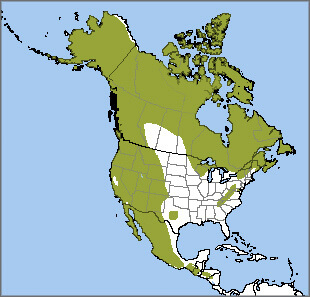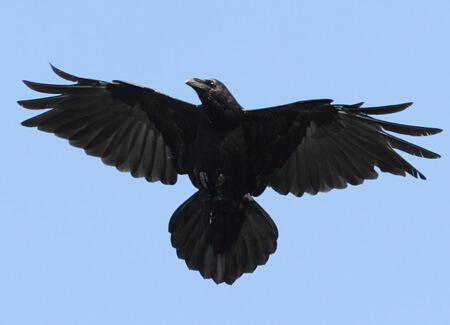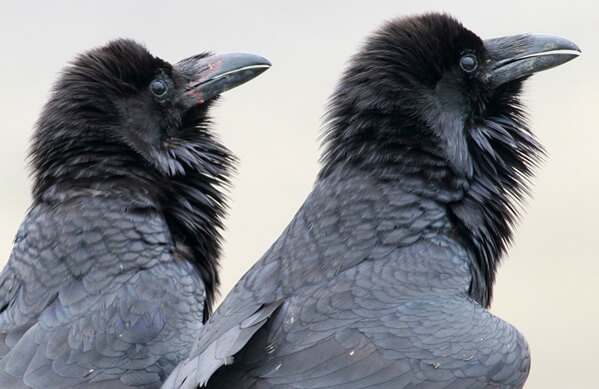 The intelligent and sociable Common Raven has been the subject of mythology, folklore, and literature through the ages. In Native American cultures, it is portrayed as a sly trickster, a spiritual figure, or even a god that helped create the earth.
The intelligent and sociable Common Raven has been the subject of mythology, folklore, and literature through the ages. In Native American cultures, it is portrayed as a sly trickster, a spiritual figure, or even a god that helped create the earth.
Others have seen the raven as a bird of death and doom, perhaps most famously by Edgar Allan Poe in his poem, "The Raven." Swedish folktales depict ravens as the ghosts of those who have been murdered, and old German stories describe ravens as damned souls.
Maybe people find ravens intimidating because they are so smart. Their brains are among the largest of any bird species, and they display excellent problem-solving ability. Biologist Bernd Heinrich, known for his studies of raven behavior, argues that the raven is one of only four known animals (along with bees, ants, and humans) with the ability to communicate about events not in the here-and-now.
Ravens have been observed demonstrating this communication capacity when a lone juvenile bird discovers a large carcass guarded by a pair of adult ravens. The juvenile raven will return to the roost and communicate the find to other birds, and the next day, a flock of unmated ravens will fly to the carcass and chase off the adults.
Playful Birds
Ravens may have a scary side, but they also are among the most playful beings in the animal kingdom. Notable among wild animals for making their own toys, they have been observed lobbing stones back and forth and breaking off twigs to play catch. Juvenile ravens slide down snowbanks and roll in fresh snow, apparently just for fun. They seem to play in the air as well, flying loop-de-loops and rolls; dive-bombing each other; and locking claws in mid-air.
They're also adaptable, found in many parts of the world in habitats from mountains to deserts. Eight subspecies are recognized over their extensive range. (Map above shows range only in Western Hemisphere.)
Ravens are easily told from their close relatives, the crows, by greater size, larger and heavier beak, shaggy feathers around the throat and beak, and wedge-shaped tail, most visible in flight. The Common Raven's deep, croaking voice is also quite distinct from the crow's characteristic “caw.”
Ravens are known for dozens of other vocalizations, though, most of which are used for social interaction. Like other members of the crow family, ravens are talented mimics and copy many sounds from their environment, including human speech.
Flexible Feeders
Common Ravens are omnivorous and highly opportunistic: Their diet varies according to their location, the season, and what's available. Although best known as scavengers, ravens are also effective hunters and sometimes hunt cooperatively. They prey on eggs and nestlings of other birds as well as rodents, grains, worms, and insects.
Like other corvids, ravens cache food, digging a hole with their bills to stash choice tidbits for later. They follow the tracks of other predators, such as wolves, to their kills in the hope of scraps. They have even been known to tug on tail feathers of raptors such as Bald Eagle to distract the larger birds from a carcass.
Sign up for ABC's eNews to learn how you can help protect birds
Avian Devotion
Common Ravens are monogamous and form long-term pair bonds when they are between 2 and 4 years old. Pairs court through acrobatic flight displays, mutual preening, and beak caressing. These devoted birds even travel as mated pairs, although juvenile birds may form flocks. During the winter, Common Ravens may also gather in flocks to forage by day and roost at night.

Common Raven by taviphoto, Shutterstock
Ravens build large nests of sticks that they sometimes reuse in consecutive years. (If unused, some hawks and owls will readily reuse the nests.) They usually build nests on a cliff ledge or high in a tall tree, but these resourceful birds will also nest on communication towers, bridges, and other man-made structures.
The Grouse Connection
Although Common Ravens were once commonly persecuted as pests, their numbers are generally stable or rising in western North America. This clever species tends to do well around human development and the garbage, crops, and roadkill that accompany it.
In the West's sagebrush country, human encroachment has boosted raven populations at the expense of Greater Sage-Grouse. Occasionally, efforts are put forward to reduce raven populations as a way to help the grouse, rather than focusing on the most important factor limiting grouse numbers: habitat loss. You can help maintain habitat for ravens, grouse, and other birds by adding your voice by speaking out during Interior's comment period and by sending letters to decision-makers via our action alert system.
An Inspiring Species
Even though some consider ravens an ill omen, others consider them a sign of good luck. Captive Common Ravens have been kept at the England's Tower of London since the 17th century; legend says that if the birds ever leave the tower, the British Empire will fall.
It seems that almost anywhere the Common Raven is found, people attribute special powers to it. A bird that has inspired so many myths and legends through the ages is a special one indeed.
Donate to support ABC's conservation mission!



















































